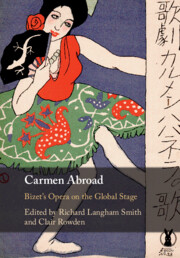Book contents
- Carmen Abroad
- Carmen Abroad
- Copyright page
- Contents
- Figures
- Tables
- Preface
- Acknowledgements
- Notes on Contributors
- Part I Establishment in Paris and the Repertoire
- Part II Across Frontiers
- Part III Localising Carmen
- 17 Russian Carmens and ‘Carmenism’: From Imperial Import to Ideological Benchmark
- 18 The Other Reversed? Japan’s Assimilation of Carmen, 1885 to 1945
- 19 Flamenco and the ‘Hispanicisation’ of Bizet’s Carmen in the Belle Epoque
- 20 Carmen at Home: Between Andalusia and the Basque Provinces, 1845 to 1936
- 21 Carmen in the Midi Amphitheatres: A ‘Tauro-Comique’ Spectacle
- Selected Bibliography
- Index
- References
19 - Flamenco and the ‘Hispanicisation’ of Bizet’s Carmen in the Belle Epoque
from Part III - Localising Carmen
Published online by Cambridge University Press: 18 September 2020
- Carmen Abroad
- Carmen Abroad
- Copyright page
- Contents
- Figures
- Tables
- Preface
- Acknowledgements
- Notes on Contributors
- Part I Establishment in Paris and the Repertoire
- Part II Across Frontiers
- Part III Localising Carmen
- 17 Russian Carmens and ‘Carmenism’: From Imperial Import to Ideological Benchmark
- 18 The Other Reversed? Japan’s Assimilation of Carmen, 1885 to 1945
- 19 Flamenco and the ‘Hispanicisation’ of Bizet’s Carmen in the Belle Epoque
- 20 Carmen at Home: Between Andalusia and the Basque Provinces, 1845 to 1936
- 21 Carmen in the Midi Amphitheatres: A ‘Tauro-Comique’ Spectacle
- Selected Bibliography
- Index
- References
Summary
For over a century, flamenco has been closely associated with productions of Carmen around the world. Bizet’s gypsy protagonist is often depicted as a flamenco performer while it has become commonplace to perceive aspects of flamenco in Bizet’s score. Yet this nexus only developed gradually during the first three decades of the opera’s existence. Bizet was largely unfamiliar with flamenco and composed Carmen while flamenco as we recognise it today was still coalescing in Spain, especially in the flamenco-orientated cafés cantantes of Seville and Madrid. During the Belle Époque the rise of flamenco and its global recognition occurred almost in tandem with Carmen’s establishment in the international operatic repertory. French and Spanish opera singers of this period, from Emma Calvé to Elena Fons and Maria Gay, sought hispanic authenticity for their Carmens by drawing on the Spanish entertainment cultures of Seville, Granada and even Barcelona. The tripartite structure of this chapter employs the conceit of offering different perspectives on the intersection of Carmen and flamenco in the Belle Époque loosely framed around the basic elements of the artform: toque y palos, baile and cante.
Keywords
- Type
- Chapter
- Information
- Carmen AbroadBizet's Opera on the Global Stage, pp. 304 - 319Publisher: Cambridge University PressPrint publication year: 2020



